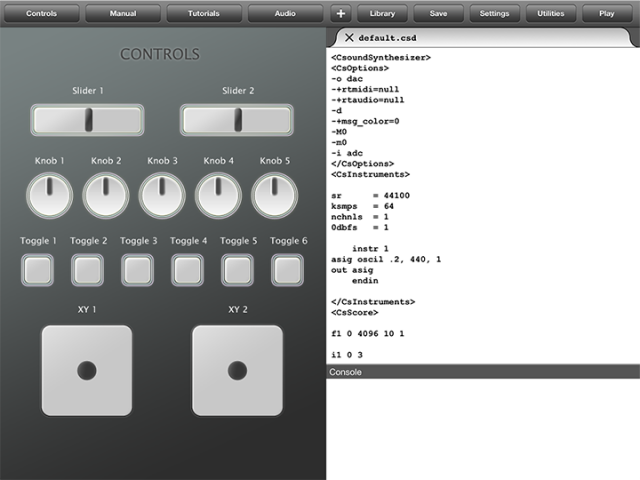And they say computer technology for music is “disposable.” Csound has a direct lineage to the very first digital audio synthesis ever to run on computers, counting decades of history. It remains an elegant way to make any instrument, event, or musical creation you can imagine, all with a free tool. And now, a Csound file can be baked right into an app for iOS, if you so desire.
Whether or not you’re ready to tinker with code, that means more musical goodies for your sonic amusement. And the next in line is something called csSpectral. Boulanger Labs has been hard at work on this one, and it looks like it will yield some insane sonic frontiers.
Information:
The new Csound-based iOS app by Boulanger Labs, csSpectral. Deepak Gopinath (Lead iOS Developer) is using csSpectral to play back a simple beat and transforms the rhythms into a unique percussion track that morphs beyond glitch. This aspect of the app is well-suited for many applications ranging from advanced sound design for film to a mashup of your favorite track.
In other words, it makes crazy noises. Or, in marketing speak, it’s well suited to serenading a future mate, providing a futuristic science fiction atmosphere to your next meal, for playing to babies in their cradles to turn them superintelligent and get them into the best afterschool programs later on, or as a means to entering higher states of astral awareness.
Another video below.
More good news: @csoundcommunity tells us via Twitter, “Just like last time, the Csound .csd will be available to investigate and learn from. Takahiko Tsuchiya takes it to another level!” And for Max fans, “there will be a Max patch avail on release w/MIDI learn. Controllers programmed on the fly, even the APC!”
If you’re ready to make your own app powered by Csound, we’ve got good news for you: there’s a free tutorial to get you started. Download the PDF and, provided you’ve got the Apple SDKs configured for building apps, you’re all set to turn your Csound files into apps:
Csound for iOS API: A Beginner’s Guide 1.0 [PDF download, University of York]
Authors: Timothy Neate, Nicholas Arner & Abigail Richardson
One note: I see they make reference to the need to use “dealloc.” Checked with Nicholas on this, and it seems the Csound API doesn’t yet support Automatic Reference Counting (ARC), so dealloc is needed. (You can actually remove the dealloc statements from the libpd examples, as it does support ARC, just so you know. It’s a small detail in the real world, though.)
Otherwise, you’ll see an approach very similar to what we’ve discussed in the free and open source libpd library:
I’ll be writing soon about the experience of using that. Actually, I rather look forward to toying around with Csound again, since Csound files can be used everywhere from Max for Live to iOS – and on completely free systems like netbooks and Raspberry Pi and Linux.
So, iOS developers have not one but two popular free and open source libraries well-suited to creating apps you can then distribute on the App Store. I think that’s utterly fantastic news. Rather than saying this is free software for the sake of it, it means the sonic creations you build can last. If you decide tomorrow you want to build a stomp box with an embedded Linux audio engine inside using your granular effect, you can – and you can sell an app on Apple’s store to fund the hardware run. Not too shabby.
Ah, but what about learning Csound? Glad you asked. Aside from having arguably the best absolute begineer guide to Pd, the volunteer-run flossmanuals comes through with a free tome on Csound.
http://en.flossmanuals.net/csound/
Or, you can just sit back and let the sonic goodness wash over you, secure in the knowledge that these creations won’t go away tomorrow just because the world moves on to some new hardware.
Now, get ready to grab your violin and play along, because here’s more reason to be excited about csSpectral:
Sneak peek of the new Csound-based iOS app by Boulanger Labs, csSpectral. Check out this demo of Takahiko Tsuchiya (Lead Sound Designer) playing violin and Paul Batchelor (SpectralEQ Designer) playing Upright Bass. Their instruments are being processed by Christopher Konopka (Sound/Layout Designer) using csSpectral for real-time acoustic processing and spectral mutation.
I’m still eager for the full Csound Touch to make its debut, but I’m sure it will be worth the wait. And lots of other sonic toys are coming, too:

No sign of this in the wild yet, but eventually you’ll be able to code for Csound right on your iPad. Photo courtesy Boulanger Labs.